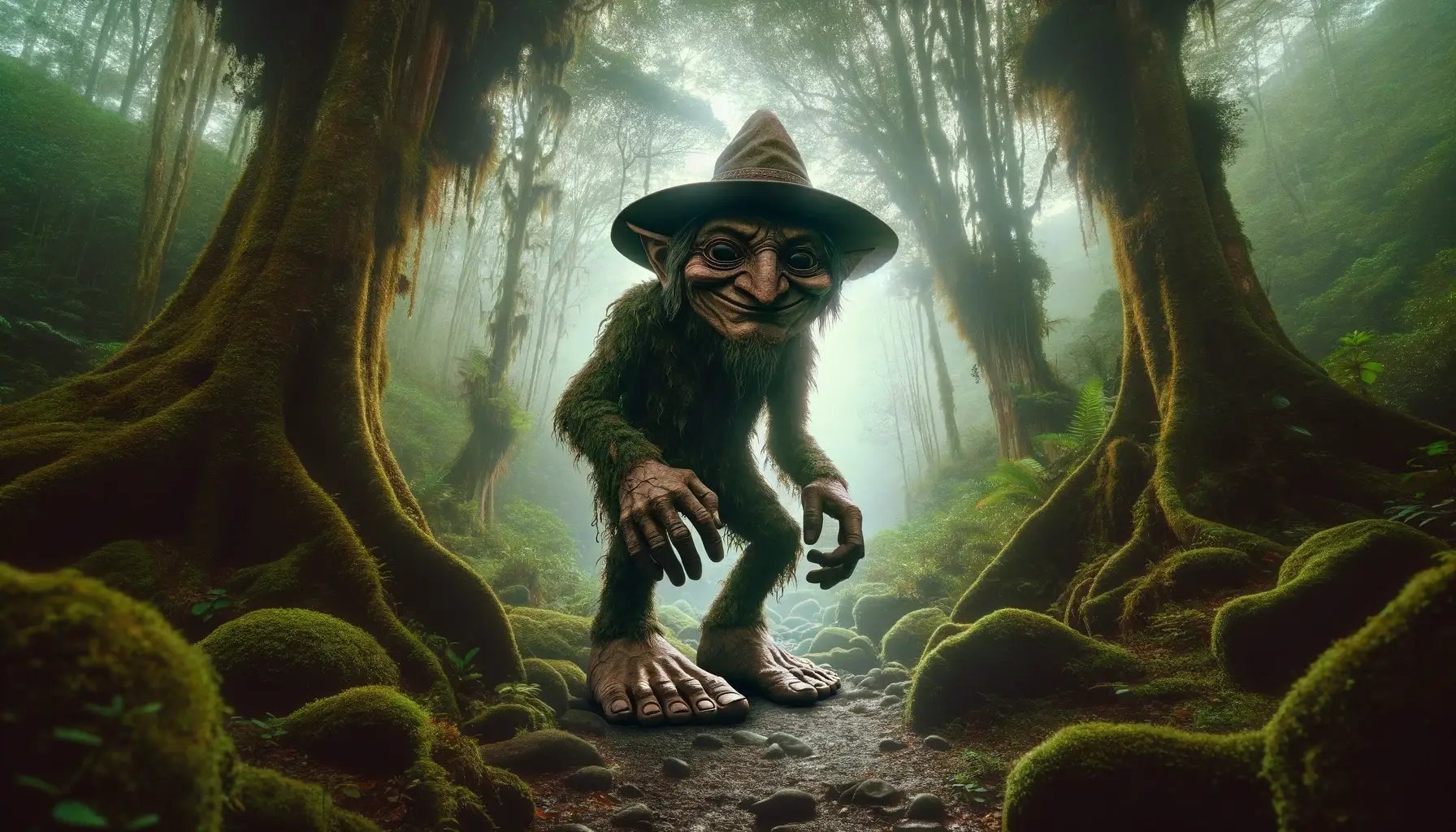The Tata Duende, a figure shrouded in the mystique of Central American folklore, stands as a testament to the rich tapestry of cultural narratives that define the region. Predominantly revered in Belize, this mythical creature captivates the imagination, embodying the essence of traditional storytelling and cultural identity. The legend of the Tata Duende, with its intricate blend of indigenous beliefs and external influences, offers a window into the soul of Belizean folklore.
At its core, the Tata Duende is more than just a mythical entity; it is a cultural symbol deeply ingrained in the collective consciousness of the people. It serves as a bridge connecting past generations with the present, a vivid reminder of a rich heritage that has been passed down through oral traditions. This enigmatic figure, often depicted as a mischievous, yet morally ambiguous character, plays a crucial role in the folklore of Belize and the wider Central American region, reflecting the values, fears, and beliefs of the communities that cherish its legend.
The tale of the Tata Duende is a confluence of mystery and morality, a narrative that has evolved over time to adapt to the changing cultural landscapes. It stands as a beacon of cultural resilience, a story that has weathered the tides of time, colonialism, and modernization, yet retained its core essence. In the hearts and minds of those who grew up listening to tales of the Tata Duende, it remains an enduring symbol of their cultural heritage, a cherished part of their folklore that continues to fascinate and educate.
Historical Background and Development
The origins of the Tata Duende are as elusive as the creature itself, deeply rooted in the indigenous cultures of Central America. The legend is believed to have originated from the Maya civilization, where such mythological figures were integral to the culture’s cosmology and storytelling traditions. Over centuries, the legend of the Tata Duende evolved, absorbing elements from European folklore introduced during the colonial era. This cultural syncretism gave the Tata Duende its unique characteristics that are known today.
The Tata Duende’s story is a vivid example of how folklore adapts to different historical and cultural contexts. As European influence permeated Central American culture, elements of their folklore, like the leprechauns and goblins, blended with indigenous legends, giving rise to a unique mythological creature that mirrored the hybrid nature of post-colonial Central American society. This fusion of cultures is reflected in the evolving portrayal of the Tata Duende, which amalgamates various cultural elements into its narrative.
The impact of colonialism on the legend is particularly noteworthy. The Tata Duende, like many indigenous myths, underwent a transformation under colonial rule. The creature’s characteristics and stories were adapted, possibly to make them more comprehensible to the European settlers or as a means of preserving indigenous culture under the guise of a more ‘acceptable’ form. This period was crucial in shaping the modern perception of the Tata Duende, molding it into a figure that was both familiar to the European settlers and resonant with the indigenous populations.
As the Tata Duende narrative passed through generations, it became a repository of cultural memory and identity. Its evolution mirrors the historical journey of the people themselves, encapsulating their struggles, resilience, and adaptability. The Tata Duende’s story is not just a tale from the past; it is a living narrative that continues to evolve, reflecting the ever-changing cultural landscape of Central America.
Physicality and Behavior
The Tata Duende is distinguished by its unique and somewhat eerie physical characteristics. Most notably, it is often depicted with backward-facing feet, a feature that confounds those who attempt to track its movements. This inversion of the natural order is symbolic, hinting at the creature’s connection to a world beyond the ordinary, a realm where the conventional rules of nature are subverted. Adding to its enigmatic appearance is the absence of thumbs, a detail that deepens its mythic quality and sets it apart from human beings.
Adorned typically with a wide-brimmed hat that conceals its face, the Tata Duende is a figure of mystery and intrigue. This attire is not just a sartorial choice but a deliberate element of its lore, contributing to its elusive and hidden nature. The creature’s physical appearance is not just a matter of aesthetics but imbued with rich symbolic meaning, representing the unknown and the unseen forces that govern the natural world.
Behaviorally, the Tata Duende is known for its mischievous and sometimes malevolent actions, particularly towards children and travelers. It is said to lure children into the forest, teaching them a lesson about the dangers of wandering alone. To travelers, it presents a trickster’s challenge, testing their wits and their respect for the natural world. These behaviors are not mere acts of whimsy; they serve a deeper purpose in the folklore. The Tata Duende, through its actions, imparts lessons of caution, respect for nature, and the importance of community values.
Cultural Connections and Importance
For many of those who reside in Central America, the Tata Duende is not just a mythical creature but a cultural icon, embodying the rich tradition of storytelling and moral instruction. Its legend is deeply interwoven with the cultural fabric of Belize and the wider region, serving as a touchstone for communal values and beliefs. The Tata Duende’s story is a cultural conduit, through which generations have passed down wisdom, warnings, and an appreciation for the mysteries of the natural world.
The creature’s significance extends beyond mere folklore; it is a symbol of cultural resilience and identity. In a world where modernity and globalization threaten to erode traditional beliefs and practices, the Tata Duende stands as a bastion of cultural heritage. It is a reminder of the power of oral traditions and the importance of preserving these stories for future generations.
Moreover, the Tata Duende’s legend highlights the intricate relationship between humans and nature in Central American cultures. The creature is often portrayed as a guardian of the forest, a representation of the respect and reverence that indigenous cultures hold for the natural world. This aspect of the legend is particularly relevant in contemporary discussions about environmental conservation and sustainable living.
The Tata Duende is much more than a figure of myth and legend. It is a cultural emblem, a guardian of tradition, and a teacher of timeless values. Its story, woven into the fabric of Central American folklore, continues to captivate, educate, and inspire, reminding us of the enduring power of cultural narratives in shaping our understanding of the world.
Moral Lessons
The Tata Duende, in its enigmatic presence, transcends the realm of mere folklore to become a moral compass and a social educator. The creature’s antics and interactions are not just for entertainment; they carry profound moral and social implications. Traditionally, tales of the Tata Duende serve as cautionary narratives, warning children of the dangers of disobedience and straying too far from home. This aspect of the legend underscores the community’s emphasis on safety, respect for parental guidance, and awareness of the environment.
Furthermore, the Tata Duende’s role in folklore is instrumental in instilling a deep respect for nature. As a guardian of the forests, the creature embodies the delicate balance between humans and the natural world. Through its stories, children and adults alike are taught to approach nature with reverence, a lesson increasingly significant in today’s context of environmental challenges. The Tata Duende, thus, serves as a symbol of ecological consciousness, embedding environmental values within the fabric of cultural narratives.
Moreover, the legend of the Tata Duende plays a vital role in reinforcing social cohesion. These stories, shared among families and communities, strengthen communal bonds and collective identity. The Tata Duende, as a shared cultural icon, becomes a focal point for communal gatherings and storytelling, an integral part of social interaction and cultural transmission.
Current Cultural Imprint
In contemporary times, the Tata Duende continues to hold a significant place in Central American, particularly Belizean, culture. While modernity has transformed many aspects of daily life, the legend of the Tata Duende persists, adapting to new forms of media and expression. In literature, art, and even modern digital media, the Tata Duende is often depicted, reflecting its continued relevance and appeal.
The creature has also found its way into the realm of tourism and cultural festivals, where it serves as an intriguing aspect of Belizean heritage for visitors. Effigies and representations of the Tata Duende are common in cultural exhibitions, showcasing the rich folklore of the region. This not only preserves the legend but also helps in sharing it with a broader audience, ensuring that the tale of the Tata Duende reaches beyond its traditional boundaries.
In popular culture, the Tata Duende has been referenced in various forms, from children’s books to television programs, indicating its adaptability and enduring appeal. These modern renditions often reinterpret the legend, sometimes in a lighter, more accessible format, making the Tata Duende a part of contemporary cultural dialogue.
Closing Thoughts
The legend of the Tata Duende, with its deep roots in Central American folklore, is a vivid tapestry woven from threads of myth, morality, and cultural identity. This enigmatic figure, embodying the mysteries of nature and the complexities of human behavior, has traversed centuries, evolving yet retaining its essence. It serves as a cultural beacon, guiding moral values, reinforcing social norms, and reminding us of our intrinsic connection to the natural world.
In a rapidly changing world, where traditional beliefs face the onslaught of modernity, the Tata Duende stands resilient, adapting to new contexts and mediums. Its story, continuously retold and reimagined, remains a vital part of Central American cultural heritage. As a symbol of tradition, a guardian of the environment, and a vehicle for moral instruction, the Tata Duende’s legend transcends the boundaries of folklore to become an enduring part of the cultural landscape, reminding us of the enduring power and relevance of our ancestral narratives.
At Ancient Theory we only use trusted sources to document our articles. Such relevant sources include authentic documents, newspaper and magazine articles, established authors, or reputable websites.






